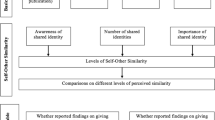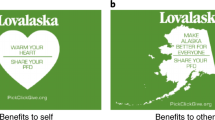Abstract
This study establishes the applicability of benefit segmentation to gift giving behavior in American philanthropy. Dimensions of the fundraising ‘product’ and resultant benefit segments are developed from a sample of donors across the continental United States. Five donor segments are presented that demonstrate face validity, predictive validity, and strategic practicality. Both donor and community-based socio-economic characteristics are important descriptors of differences between donor segments. Implications of these findings are discussed.
Similar content being viewed by others
References
Americans Volunteer 1985 1986. Washington DC: The Independent Sector.
Andreasen, A. R. 1982. “Nonprofits: Check Your Attention to Customers.”Harvard Business Review (May–June): 105–110.
— 1985. “A Marketing Challenge for United Way.”Community, September: 14–16.
Beik, L. L. and S. M. Smith 1977. “Contribution Segmentation: Improved Fund Raising for the American Heart Association.” Dallas TX: The American Heart Association.
Bogdanich, W. 1985. “It's Hard to Tell Good Charities From the Bad.”Wall Street Journal January 25: 23.
Bonaguro, J. A. and G. Miaoulis 1983. “Marketing: A Tool for Health Education Planning.”Health Education (January–February) 9.
Buzzell, R. D. 1970.How Can Research Contribute to Improved Marketing in Non-Business Organizations. Boston: Marketing Science Institute.
The Chronicle of Higher Education 1988. “Wealthy People Give Less Generously Than Once Thought, Survey Finds.” October 26: A37–A39.
Curti, M. 1983. “American Philanthropy and the National Character.” in (ed.) Brian O'Connell,America's Voluntary Spirit New York: The Foundation Center: 161–179.
Danko, W. D. and T. J. Stanley 1986. “Identifying and Reaching the Donation Prone Individual: A Nationwide Assessment.”Journal of Professional Services Marketing 2 (Fall/Winter): 117–122.
Edmondson, B. 1986. “Who Gives to Charity?”American Demographics November: 45–49.
Engelman, L. and J. A. Hartigan 1983. “PKM 17.3. K-Means Clustering.” in (eds.) W. J. Dixon, et al.BMDP Statistical Software Berkeley, CA: University of California Press: 464–473.
Farhi, P. 1988. “Contributions to Charities Set Record in ′87.”Wall Street Journal June 23: C1.
Fox, K.F.A. and P. Kotler 1980. “The Marketing of Social Causes: The First Ten Years,”Journal of Marketing 44 (Fall): 24–33.
Fraser, C., R.E. Hite and P.L. Sauer 1988. “Increasing Contributions in Solicitation Campaigns: The Use of Large and Small Anchorpoints.”Journal of Consumer Research 15 (September): 284–287.
Funkhouser, G.R. 1983. “A Note on the Reliability of Certain Clustering Algorithms.”Journal of Marketing Research 20 (February): 99–102.
Giving USA 1988. 1988 Annual Report. New York: American Association of Fund Raising Counsel.
Guy, B.S. and W.E. Patton 1989. “The Marketing of Altruistic Causes: Understanding Why People Help.”The Journal of Consumer Marketing 6 (Winter): 19–30.
Haley, R.I. 1968. “Benefit Segmentation: A Decision-oriented Research Tool.”Journal of Marketing 32 (July): 30–35.
— 1971. “Beyond Benefit Segmentation,”Journal of Advertising Research 11 (August): 3–8.
— 1984a. Benefit Segments: Backwards and Forwards.”Journal of Advertising Research 24 (February–March): 19–25.
— 1984b. “Benefit Segmentation—20 Years Later,”Journal of Consumer Marketing 1 (2): 5–13.
— 1985. “Developing Effective Communications Strategy: A Benefit Segmentation Approach.” New York: John Wiley & Sons.
Haring, A. 1973. “Work or Welfare: An Attitude Segmentation of ADC Client.” New York: Human Resources Administration.
Harvey, J.W. and K.F. McCrohan 1988a. “Fundraising Costs—Societal Implications for Philanthropies and Their Supporter.”Business and Society 27 (Spring): 15–22.
— 1988b. “Strategic Issues for Charities and Philanthropies.”Long Range Planning 21 (6): 44–55.
Hodgkinson, V.A. 1985. “Positioning Ourselves as a Sector: Research and Public Policy.”Journal of Voluntary Action Research 14 (April–September): 17–24.
Klastorin, T.D. 1983. “Assessing Cluster Analysis Results.”Journal of Marketing Research 20 (February): 92–98.
Kotler, P. and A.R. Andreasen 1987.Strategic Marketing for Nonprofit Organizations, Englewood Cliffs, NJ: Prentice-Hall.
Krech, D., and R. S. Crutchfield (1948).Theory and Problems of Social Psychology. New York: McGraw-Hill Book Co.
Lamb, Jr. C. M. 1987. “Public Sector Marketing is Different.”Business Horizons 30 (4): 56–60.
Lovelock, C. H., and C. B. Weinberg 1984.Marketing for Public and Nonprofit Managers. New York: John Wiley & Sons.
Marketing Canada as a Vacation Nation 1977. In B.M. Rusk, Y. Wind and M.G. Greenberg (eds.)Moving A Head with Attitude Research Chicago, IL: American Marketing Association.
McElroy, K. M., and J. J. Siegfried 1986. “The Community Influence on Corporate Contributions.”Public Finance Quarterly 14 (October): 394–414.
Mindak, W. A., and H. M. Bybee 1971. “Marketing's Application to Fund Raising.”Journal of Marketing 35 (July): 13–18.
Moore, L. F. 1983. “Organizational Imagery and Voluntarism.” In M. S. Moyer (ed.)Managing Voluntary Organizations Conference Proceedings, York University, October.
Myers, J. H., and M. I. Alpert 1968. “Determinant Buying Attitudes: Meaning and Measurement.”Journal of Marketing 32 (October): 13–20.
Punj, G., and D. W. Stewart 1983. “Cluster Analysis of Marketing Research: Review and Suggestions for Application.”Journal of Marketing Research 20 (May): 122–123.
Rich, S. 1987. “Few Rich Are Exceptionally Charitable, Study Says.”The Washington Post September 21: A12.
Riecken, G., and U. Yavas 1986. “Seeking Donors via Opinion Leadership.”Journal of Professional Services Marketing 2 (Fall/Winter): 109–116.
Ryan, D., and R. Murdock 1986. “Identifying and Nurturing Core Donors.”Fund Raising Management 16 (February): 20–32.
Shapiro, B.P. 1973. “Marketing for Nonprofit Organizations.”Harvard Business Review (September–October): 43–52.
Smith, S. M. 1980. “Giving to Charitable Organizations: A Behavioral Review and A Framework for Increasing Commitment.” in Jerry C. Olson (ed.),Advances in Consumer Research 7. Ann Arbor MI: The Association for Consumer Research: 753–756.
Steiber, S.R., and J.A. Boscarino 1983. “Qualitative Forecasting Tools Help to Pinpoint Health Care Market Segments.”Marketing News October: 4.
Steinberg, M., G. Miaoulis, and D. Lloyd 1982. “Benefit Segmentation Strategies for the Performing Arts.” In1982 Educators Conference Proceedings B.J. Walker (ed.): 289–293.
Tabachnick, B. G. and L. S. Fidell 1983.Using Multivariate Statistics New York: Harper and Row.
TQ ConsultantsThe Hoover Awards for Marketing 1978 1978. Victoria, Australia: TQ Consultants, summarized in Lovelock and Weinberg,op cit, Lovelock, C. H., and C. B. Weinberg 1984.Marketing for Public and Nonprofit Managers. New York: John Wiley & Sons. 1984: 411–412.
Traynor, K. 1981, “A Benefit Analysis of Higher Education Using Multiple Discriminant Analysis.” In J. H. Donnelly and W. R. George (eds.)Marketing of Services. Chicago IL: American Marketing Association: 129–133.
Varadarajan, P. R., and A. Menon 1988. “Cause-Related Marketing: A Coalignment of Marketing Strategy and Corporate Philanthropy.”Journal of Marketing 52 (July): 58–74.
Wall Street Journal 1988. Business Bulletin—A Special Background Report On Trends in Industry and Finance. June 30: 1.
Yavas, U., G. Riecken, and R. Parameswaran 1980. “Personality, Organization-Specific Attitude, and Socioeconomic Correlates of Charity Giving Behavior.”Journal of the Academy of Marketing Science 9 (Winter): 52–64.
Author information
Authors and Affiliations
Rights and permissions
About this article
Cite this article
Harvey, J.W. Benefit segmentation for fund raisers. JAMS 18, 77–86 (1990). https://doi.org/10.1007/BF02729764
Issue Date:
DOI: https://doi.org/10.1007/BF02729764




